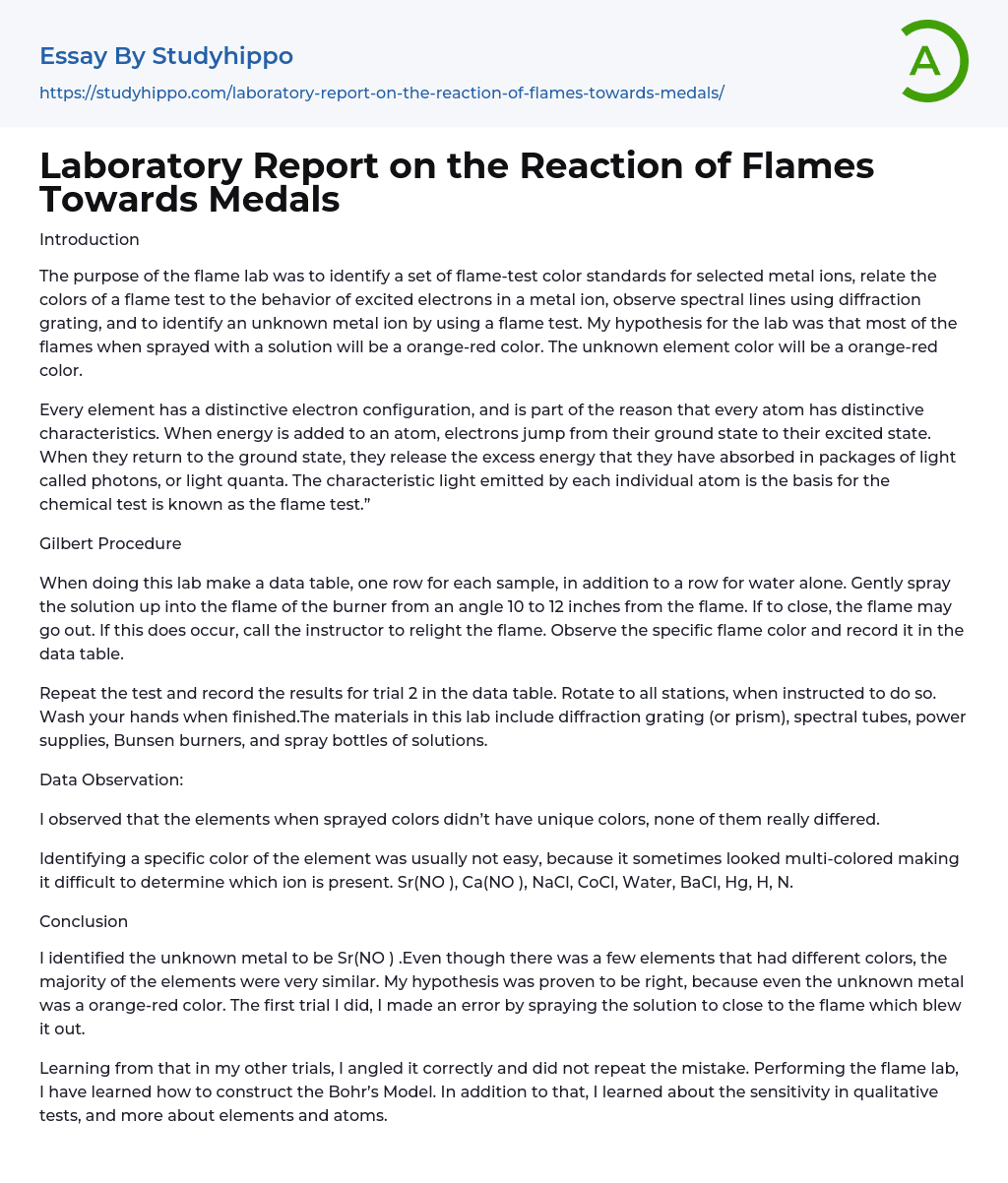
Introduction
The purpose of the flame lab was to identify a set of flame-test color standards for selected metal ions, relate the colors of a flame test to the behavior of excited electrons in a metal ion, observe spectral lines using diffraction grating, and to identify an unknown metal ion by using a flame test. My hypothesis for the lab was that most of the flames when sprayed with a solution will be a orange-red color. The unknown element color will be a orange-red color.
Every element has a distinctive electron configuration, and is part of the reason that every atom has distinctive characteristics. When energy is added to an atom, electrons jump from their ground state to their excited state. When they return to the ground state, they release the excess energy that they have abs
...orbed in packages of light called photons, or light quanta. The characteristic light emitted by each individual atom is the basis for the chemical test is known as the flame test.”
Gilbert Procedure
When doing this lab make a data table, one row for each sample, in addition to a row for water alone. Gently spray the solution up into the flame of the burner from an angle 10 to 12 inches from the flame. If to close, the flame may go out. If this does occur, call the instructor to relight the flame. Observe the specific flame color and record it in the data table.
Repeat the test and record the results for trial 2 in the data table. Rotate to all stations, when instructed to do so. Wash your hands when finished.The materials in this lab include diffraction grating (or prism), spectral
tubes, power supplies, Bunsen burners, and spray bottles of solutions.
Data Observation:
I observed that the elements when sprayed colors didn’t have unique colors, none of them really differed.
Identifying a specific color of the element was usually not easy, because it sometimes looked multi-colored making it difficult to determine which ion is present. Sr(NO ), Ca(NO ), NaCl, CoCl, Water, BaCl, Hg, H, N.
Conclusion
I identified the unknown metal to be Sr(NO ) .Even though there was a few elements that had different colors, the majority of the elements were very similar. My hypothesis was proven to be right, because even the unknown metal was a orange-red color. The first trial I did, I made an error by spraying the solution to close to the flame which blew it out.
Learning from that in my other trials, I angled it correctly and did not repeat the mistake. Performing the flame lab, I have learned how to construct the Bohr’s Model. In addition to that, I learned about the sensitivity in qualitative tests, and more about elements and atoms.
- Accounting essays
- Marketing essays
- Automation essays
- Business Cycle essays
- Business Model essays
- Business Operations essays
- Business Software essays
- Corporate Social Responsibility essays
- Infrastructure essays
- Logistics essays
- Manufacturing essays
- Multinational Corporation essays
- Richard Branson essays
- Small Business essays
- Cooperative essays
- Family Business essays
- Human Resource Management essays
- Sales essays
- Market essays
- Online Shopping essays
- Selling essays
- Strategy essays
- Management essays
- Franchising essays
- Quality Assurance essays
- Business Intelligence essays
- Corporation essays
- Stock essays
- Shopping Mall essays
- Harvard Business School essays
- Harvard university essays
- Trade Union essays
- Cooperation essays
- News Media essays
- Waste essays
- Andrew Carnegie essays
- Inventory essays
- Customer Relationship Management essays
- Structure essays
- Starting a Business essays
- Accounts Receivable essays
- Auditor's Report essays
- Balance Sheet essays
- Costs essays
- Financial Audit essays
- International Financial Reporting Standards essays
- Tax essays
- Accountability essays
- Cash essays
- Principal essays



